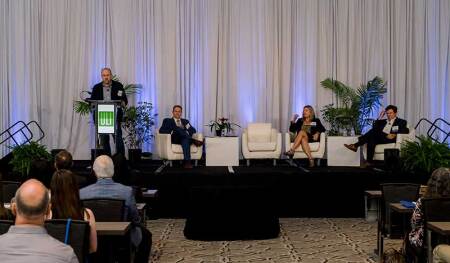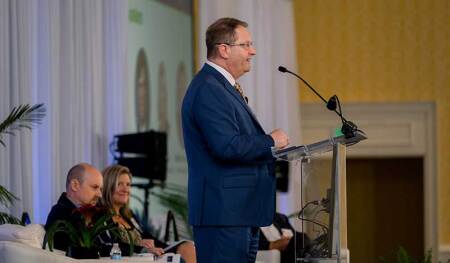Three game-changing projects in central Florida were highlighted during the 2019 ULI Florida Summit, with each taking a long view of remaking historic spots while gauging next-generation needs, including education needs in the region and the shifting needs of retail and industrial uses.
Framing the discussion, Pete Sechler, director, GAI Community Solutions Group, recounted changes in the development landscape as he welcomed attendees at the Gaylord Palms Convention Center in Kissimmee.
Just a generation ago, residential development in central Florida was largely golf-course centric. Downtown living was limited. Few could have imagined that 8,000 students would be headed to a downtown Orlando university campus.
Like urban areas throughout Florida and elsewhere, Orlando’s growth patterns have changed since the 1990s. Executives and visionaries behind three projects communicated how they planned to shape them over time.
“We go into it with a patient and long-term view,” said Craig Collin, a Tavistock Development Company executive helping oversee a decades-long rollout of the Lake Nona community.
Packing District
On the edge of Orlando’s original bedroom community stands the reinvention of an old citrus and warehouse operation straddling 200 acres (81 ha) threaded with railroad tracks and cypress swamp.
Its history is rooted in citrus magnate Dr. P. Phillips selling oranges as a prescription for good health. Warehouses built there in the 1930s and 1940s also housed Sears & Roebuck and Nabisco suppliers.
When the operations closed due to shifting supply and demand, homeless camps emerged. Deep muck beds presented development challenges, but rising land prices and a strong location stirred prospects.
Two years ago, the Packing District concept emerged, with Dr. Phillips Charities donating the acreage to the city of Orlando and working with various partners on the multiuse project.
Details include the following:
- Half the acreage will become a 40-acre (16 ha) operating farm, agriculture center, and parks.
- The old Great Southern Box Company building will get another life as a food hall with vendors leasing stalls in an open-air venue.
- In addition to the townhouses and apartments, plans call for a network of connected plazas with 6,000 square feet (557 sq m) of retail.
- With space to seat as many as 3,000, a central hall could accommodate concerts, a farmers market, or weddings.
The developer is working with David Weekley and Embrey Partners on residential. The Dr. Phillips nonprofit organization donated $9 million to help finance a YMCA. In addition, the city is relocating its downtown Orlando tennis center there.
The partners are proceeding on the $480 million project at a measured pace.
“We don’t take on debt, so it’s a slow process,” says Kenneth Robinson, president of Dr. Phillips Charities.
He said the development team hoped to reconfigure two key roads—Princeton and Smith streets—from one-way traffic to two-way.
“We realized it was too much beyond our control,” he told the audience. “The same goes for the railroad tracks. We are working with what we have and planning for what could be.”

From left to right: Craig Collin, senior vice president, Tavistock Development Company; Pete Sechler, director, GAI Community Solutions Group; Brooke Myers, founder and president, VelocityRED; and Kenneth Robinson, president and CEO, Dr. Phillips, speaking at the 2019 ULI Florida Summit in Kissimmee.
Creative Village
In the western shadow of downtown Orlando—cut off from the business district by an elevated interstate—a historically African American community is being remade.
The footprint for the soon-to-open downtown campus of the University of Central Florida and Valencia College emerged from the demolition dust of the Amway Center basketball arena in 2012.
Ustler Development, in partnership with Bank of America, won from the city rights to develop 68 acres (27.5 ha) over time with the directive that they honor the longtime residents.
Ustler and DEVEN Development Ventures Group are now completing a $105 million student housing project with 600 beds, 600 spaces of integrated parking, 105,000 square feet (9,755 sq m) of office space and 12,000 square feet (1,115 sq m) of ground-floor commercial space.
Working with the city, master developers gradually take down parcels for groups looking to construct affordable and market-rate apartments, campus buildings, and retail uses. Land is under purchase option through 2031.
Without the luxury of the city’s long-term agreement, more marginal uses might have won.
“If it was all at once, the burden of land costs would have led to self-storage and other similar uses,” said Brooke Myers, president of development partner VelocityRED.
She added that the development team gets favorable pricing on the property in recognition of sweat equity.
Lake Nona
With a decades-long approach to redefining 17 square miles (44 sq km) of former pastures near Orlando International Airport, Lake Nona forges ahead with a national tennis campus, a KPMG training center, walkable neighborhoods, and a new shipping-container park of eateries.
Backed by the Tavistock Company, developers have some latitude to consider future impacts.
“We’re about to start a parking garage, but you won’t have parking garages in 20 years the way you do now,” Collin said. “Autonomous vehicles are changing the way even roads are being built. What will we do with garages?”
Details include the following:
- An iconic Veterans Administration Medical Center, with more than 1 million square feet (92,900 sq m), includes a simulated learning center.
- Hotels are operated by the developer and feature some oversized rooms to accommodate fitness training.
- A wellness center, with 110,000 square feet (10,200 sq m), will have physician offices.
- Twelve shipping containers have been repurposed as a 30,000-square-foot (2,800 sq m) park with test kitchens and diverse food options.
As it has evolved, developers scaled back plans for 100 micro-unit apartments to offer six of the rentals. That is just one example of changes that emerge as plans get vetted, Collin said.
Overall, during the opening session of the conference, the three projects demonstrated how stable government leadership and deeper financial commitments allow developments to prosper, said Jacksonville engineer Bill Myers.
“I’ve been impressed with the ability of the Orlando development community, both public and private, to collaborate on projects like the Packing District, Lake Nona, and Creative Village,” said Myers, who is part of a team organizing next year’s conference.
He added that he was also impressed with the implementation of a long-term vision “because of the consistency in the mayoral administration and the lack of term limits.”
MARY SHANKLIN is a reporter specializing in commercial and residential real estate.


